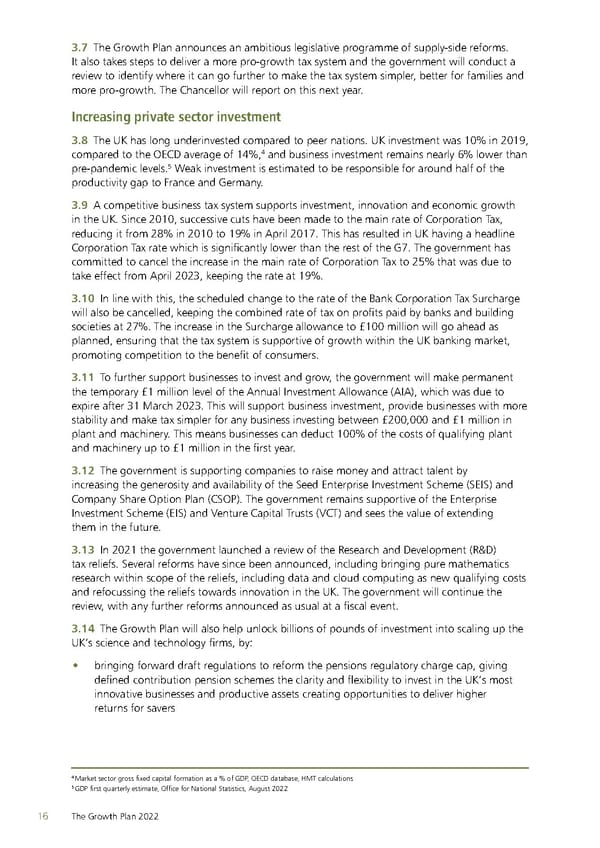3.7 The Growth Plan announces an ambitious legislative programme of supply-side reforms. It also takes steps to deliver a more pro-growth tax system and the government will conduct a review to identify where it can go further to make the tax system simpler, better for families and more pro-growth. The Chancellor will report on this next year. Increasing private sector investment 3.8 The UK has long underinvested compared to peer nations. UK investment was 10% in 2019, 4 compared to the OECD average of 14%, and business investment remains nearly 6% lower than 5 pre-pandemic levels. Weak investment is estimated to be responsible for around half of the productivity gap to France and Germany. 3.9 A competitive business tax system supports investment, innovation and economic growth in the UK. Since 2010, successive cuts have been made to the main rate of Corporation Tax, reducing it from 28% in 2010 to 19% in April 2017. This has resulted in UK having a headline Corporation Tax rate which is significantly lower than the rest of the G7. The government has committed to cancel the increase in the main rate of Corporation Tax to 25% that was due to take effect from April 2023, keeping the rate at 19%. 3.10 In line with this, the scheduled change to the rate of the Bank Corporation Tax Surcharge will also be cancelled, keeping the combined rate of tax on profits paid by banks and building societies at 27%. The increase in the Surcharge allowance to £100 million will go ahead as planned, ensuring that the tax system is supportive of growth within the UK banking market, promoting competition to the benefit of consumers. 3.11 To further support businesses to invest and grow, the government will make permanent the temporary £1 million level of the Annual Investment Allowance (AIA), which was due to expire after 31 March 2023. This will support business investment, provide businesses with more stability and make tax simpler for any business investing between £200,000 and £1 million in plant and machinery. This means businesses can deduct 100% of the costs of qualifying plant and machinery up to £1 million in the first year. 3.12 The government is supporting companies to raise money and attract talent by increasing the generosity and availability of the Seed Enterprise Investment Scheme (SEIS) and Company Share Option Plan (CSOP). The government remains supportive of the Enterprise Investment Scheme (EIS) and Venture Capital Trusts (VCT) and sees the value of extending them in the future. 3.13 In 2021 the government launched a review of the Research and Development (R&D) tax reliefs. Several reforms have since been announced, including bringing pure mathematics research within scope of the reliefs, including data and cloud computing as new qualifying costs and refocussing the reliefs towards innovation in the UK. The government will continue the review, with any further reforms announced as usual at a fiscal event. 3.14 The Growth Plan will also help unlock billions of pounds of investment into scaling up the UK’s science and technology firms, by: • bringing forward draft regulations to reform the pensions regulatory charge cap, giving defined contribution pension schemes the clarity and flexibility to invest in the UK’s most innovative businesses and productive assets creating opportunities to deliver higher returns for savers 4 Market sector gross fixed capital formation as a % of GDP, OECD database, HMT calculations 5 GDP first quarterly estimate, Office for National Statistics, August 2022 The Growth Plan 2022 16
 The Growth Plan 2022 Page 16 Page 18
The Growth Plan 2022 Page 16 Page 18